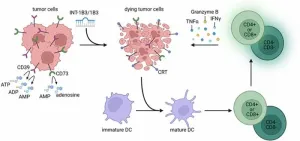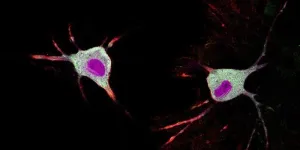(Press-News.org) Embargoed for release until 5:00 p.m. ET on Monday 5 August 2024
Annals of Internal Medicine Tip Sheet
@Annalsofim
Below please find summaries of new articles that will be published in the next issue of Annals of Internal Medicine. The summaries are not intended to substitute for the full articles as a source of information. This information is under strict embargo and by taking it into possession, media representatives are committing to the terms of the embargo not only on their own behalf, but also on behalf of the organization they represent.
----------------------------
1. Cancer screening estimated to cost $43 billion a year in the United States
Abstract: https://www.acpjournals.org/doi/10.7326/M24-0375
Editorial: https://www.acpjournals.org/doi/10.7326/M24-0887
URL goes live when the embargo lifts
A modeling study suggests that cancer screening in the United States costs more than $40 billion annually. The estimate is based on available 2021 data for costs associated with screening for 5 common types of cancer. According to the researchers, this data is critical to help inform policy and priorities, including enhancing equitable access to recommended cancer screenings. The findings are published in Annals of Internal Medicine.
Researchers from the National Institutes of Health utilized national health care survey and cost resources data to estimate the annual cost of initial cancer screening (screening without follow-up costs) in the United States in 2021. To estimate the cost, the researchers multiplied the number of people screened for breast, cervical, colorectal, lung, and prostate cancer and associated health care system costs by typical insurance cost per screen in 2021 dollars. They found that cancers screening cost an estimated $43 billion annually and colorectal cancer represented approximately 64% of the total cost. About 88.3% of costs were attributable to private insurance, 8.5% to Medicare, and 3.2% to Medicaid and other programs. Costs paid to screening facilities were a major driver of the expense. The authors emphasize that while this is a substantial total, recommended cancer screenings have been demonstrated to reduce cancer-specific mortality and screening for breast, cervical, colorectal, and lung cancers has generally been reported to be cost-effective or cost-saving in the United States. Further, recommended cancer screenings increase detection of earlier stage disease, which may result in decreased treatment costs, decreased financial hardship, and improved quality of life.
An accompanying editorial says that estimating the cost associated with cancer screening is a useful start but may be an understatement because it does not take into consideration 3 important components of screening that affect costs: subsequent testing, screening of ineligible patients, and overdiagnosis and overtreatment. In addition, the editorialists note that the current study estimated the cost of screening only for the population defined as eligible by the U.S. Preventive Services Task Force, yet data suggests that screening of ineligible patients is particularly common, especially among elderly people. According to the editorialists, the substantial resources devoted to screening may be better directed toward ensuring widespread access to effective cancer treatment and addressing the social determinants of cancer risk.
Media contacts: For an embargoed PDF, please contact Angela Collom at acollom@acponline.org. To speak with the corresponding author Michael Halpern, MD, please email michael.halpern@nih.gov.
----------------------------
2. Initial pneumonia diagnoses often revised in the hospital
Over half of pneumonia patients face diagnostic discrepancies between admission to discharge
Abstract: https://www.acpjournals.org/doi/10.7326/M23-2505
Editorial: https://www.acpjournals.org/doi/10.7326/M24-0889
URL goes live when the embargo lifts
A national cohort study representing more than 2 million patient encounters found that more than half of all patients hospitalized and treated for pneumonia experienced discordant diagnoses from their initial presentation to discharge. The research highlights a significant prevalence of treatment for other diagnoses and frequent expressions of diagnostic uncertainty, underscoring the critical need for recognizing and addressing diagnostic uncertainty in pneumonia-related care practices. The authors suggest that these findings call for enhanced attention to the diagnostic process and research that acknowledges uncertainty to improve patient outcomes in pneumonia treatment. This is important because pneumonia is the leading cause of death from infection. The study is published in Annals of Internal Medicine.
Researchers from the University of Utah and Salt Lake City VA Healthcare System used administrative data and natural language processing to study the accuracy of a diagnosis of pneumonia among over 2 million admissions to Veterans Administration hospitals between 2015 and 2022. To explore the change in a pneumonia diagnosis across a hospitalization, the researchers classified each hospitalization according to concordance or discordance in diagnoses of pneumonia between three states: initial diagnosis made in the ED; initial chest image reports; and discharge. They then measured the concordance of the admission diagnosis of pneumonia, a radiographic finding consistent with pneumonia, and a discharge diagnosis of pneumonia. They found that 36% of patients had an admitting diagnosis of pneumonia but no discharge diagnosis, and 33% had a discharge diagnosis of pneumonia, but not an admission diagnosis. Discordance between a diagnosis of pneumonia and chest radiograph findings was also common.
An accompanying editorial from the University of Connecticut School of Medicine says that clinicians accept diagnostic uncertainty in pneumonia because treating all possibilities has not been shown to be inferior to any available alternative. While CT for all patients with suspected pneumonia may improve accuracy, it still would not likely change the treatment, as symptoms and treatment of pneumonia overlap with several other conditions including heart failure and COPD. The author agrees that more research is needed and suggests that studies should quantify the level of harm related to an incorrect diagnosis of pneumonia, as doing so would better define the level of importance of interventions to address the issue.
Media contacts: For an embargoed PDF, please contact Angela Collom at acollom@acponline.org. To speak with corresponding author Barbara Jones, MD, please email Sophia Friesen at Sophia.Friesen@hsc.utah.edu or Carrie Milligan at carrie.milligan@hsc.utah.edu.
----------------------------
3. Follow up after cardiovascular hospitalizations lacking, especially among marginalized populations
Abstract: https://www.acpjournals.org/doi/10.7326/M23-3475
URL goes live when the embargo lifts
A retrospective cohort study found that between 2010 and 2019, timely post-discharge follow-up after acute myocardial infarction (AMI) and heart failure (HF) hospitalizations increased substantially for Medicare fee-for-service beneficiaries, but many patients still not getting the follow-up they need, and racial and socioeconomic disparities have worsened. This is a significant issue because timely follow-up after cardiovascular hospitalization is recommended to improve patient outcomes. The findings are published in Annals of Internal Medicine.
Researchers from the University of Pittsburgh and Harvard Medical School analyzed CMS administrative claims for all Medicare fee-for-service beneficiaries hospitalized during the period from 2010 to 2019 to describe trends and disparities in follow up after AMI (1,678,088 hospitalizations) and HF (4,245,665 hospitalizations) hospitalizations and observation stays. Participants were analyzed for receipt of a cardiology visit within 30 days of discharge and statistical models were used to estimate changes over time overall and across 5 sociodemographic characteristics based on known disparities in cardiovascular outcomes. The researchers found that nearly 40% of patients with AMI and more than 50% of patients with HF were not seen by a cardiology clinician, and nearly 20% of patients with AMI and 30% of patients with HF were not seen by any primary care or cardiology clinician within 30 days of discharge. While rates of follow up gradually improved over the decade, disparities worsened for Asian, Black, Hispanic, and Medicaid dual-eligible patients as well as patients residing in counties with higher levels of social deprivation. These findings suggest a need for equity-informed policy and health system strategies.
Media contacts: For an embargoed PDF, please contact Angela Collom at acollom@acponline.org. To speak with the corresponding author Timothy S. Anderson, MD, MAS, please email Elaine Vitone at vitoneeg@upmc.edu.
----------------------------
Also new in this issue:
The Ethics of Cancer Screening Based on Race and Ethnicity
Duco T. Mülder, MSc; James F. O'Mahony, PhD; Chyke A. Doubeni, MD, MPH; Iris Lansdorp-Vogelaar, PhD; Maartje H.N. Schermer, MD, PhD
Medicine and Public Issues
Abstract: https://www.acpjournals.org/doi/10.7326/M24-0377
END
Cancer screening estimated to cost $43 billion a year in the United States
2024-08-05
ELSE PRESS RELEASES FROM THIS DATE:
Researchers receive 9.5 million grant to study relationship between polyphenol intake, Alzheimer’s prevention, and the brain-gut-microbiome system
2024-08-05
UCLA Health researchers, in collaboration with researchers from the Republic of Ireland and Northern Ireland, have received $9.5 million award from the National Institutes of Health (NIH) with support from European funding agencies — The Science Foundation Ireland (SFI) and the Public Health Agency Health & Social Care (HSC) — to study the effects of polyphenols on cognitive health and the brain-gut microbiome system.
The proposal, named MAEVE, stands for “Microbiota mediated flavonoid metabolites for cognitive health.”
In this interdisciplinary and multicenter study funded through the Tripartite US-Ireland Research & Development Partnership Program, ...
UH astronomers uncover risks to planets that could host life
2024-08-05
A groundbreaking study has revealed that red dwarf stars can produce stellar flares that carry far-ultraviolet (far-UV) radiation levels much higher than previously believed. This discovery suggests that the intense UV radiation from these flares could significantly impact whether planets around red dwarf stars can be habitable. Led by current and former astronomers from the University of Hawaiʻi Institute for Astronomy (IfA), the research was recently published in the Monthly Notices of the Royal Astronomical Society.
“Few stars have been thought to generate ...
An overlooked side-effect of the housing crisis may be putting Californians at increased risk from climate disasters
2024-08-05
In a new article for the journal Proceedings of the National Academy of Sciences, UC Santa Cruz researchers laid out the foundation for their highly-anticipated upcoming study of how lack of affordable housing in urban areas of California may be driving increased development in and near wildlands, leading to more severe climate change impacts.
Since the 1990s, California has led the nation in the growth of Wildland-Urban Interface (WUI) development, with more than one in three households in the state now located immediately next to or within ...
INT-1B3 miR-193a-3p mimic boosts t cell immunity and induces tumor cell death
2024-08-05
BUFFALO, NY- August 5, 2024 – A new research paper was published in Oncotarget's Volume 15 on July 12, 2024, entitled, “INT-1B3, an LNP formulated miR-193a-3p mimic, promotes anti-tumor immunity by enhancing T cell mediated immune responses via modulation of the tumor microenvironment and induction of immunogenic cell death.”
In this study, researchers Chantal L. Duurland, Thijs de Gunst, Harm C. den Boer, Marion T.J. van den Bosch, Bryony J. Telford, Rogier M. Vos, Xiaolei Xie, Mingfa Zang, Fang Wang, Yingying Shao, Xiaoyu ...
Wayne State University professor receives NSF grant to study quantum tunneling
2024-08-05
DETROIT — A Wayne State University professor recently received a three-year, $626,467 grant from the National Science Foundation’s Division of Physics. The project, “Probing Nonadiabatic Strong Field Ionization with Phase-Resolved Attoclock,” will research a quantum mechanical process known as quantum tunneling.
Wen Li, Ph.D., professor of chemistry in Wayne State’s College of Liberal Arts and Sciences and his research team propose a new technique they have developed to study the process of quantum tunneling, a quantum mechanical phenomenon in which an object such as an electron or atom passes through ...
Adding metastasis-directed radiation therapy boosts progression-free survival in metastatic pancreatic cancer
2024-08-05
Researchers from The University of Texas MD Anderson Cancer Center demonstrated that adding metastasis-directed radiation therapy to standard-of-care chemotherapy improved progression-free survival (PFS) in patients with oligometastatic pancreatic cancer. Findings from the multicenter EXTEND trial, published today in the Journal of Clinical Oncology, were first presented at the 2024 American Society of Clinical Oncology (ASCO) Gastrointestinal Cancers Symposium.
At a median follow-up of 17.3 months, PFS was 10.3 months in patients who received metastasis-directed therapy (MDT) ...
New method tracks how psychedelics affect neurons in minutes
2024-08-05
Researchers at the University of California, Davis have developed a rapid, noninvasive tool to track the neurons and biomolecules activated in the brain by psychedelic drugs. The protein-based tool, which is called Ca2+-activated Split-TurboID, or CaST, is described in research published in Nature Methods.
There has been mounting interest in the value of psychedelic-inspired compounds as treatments for brain disorders including depression, post-traumatic stress disorder and substance use disorder. Psychedelic ...
Record number of drug overdoses in one year reported
2024-08-05
August 4, 2024-- Drug-involved overdose deaths increased by over 500 percent in 2022 according to a study at Columbia University Mailman School of Public Health, with trends attributed to synthetic opioids. National data shows that fentanyl and heroin in particular attributed substantially to the rise particularly since 2014. However, the study also reports that income protection policies, can have a supportive role in preventing fatal drug overdoses. The findings are reported in the International ...
Could this new drug turn back the clock on multiple sclerosis?
2024-08-05
Could This New Drug Turn Back the Clock on Multiple Sclerosis?
Ten years of work, and a little help from the green mamba snake, has resulted in a promising new drug that is already being tested in clinical trials.
Multiple sclerosis (MS) degrades the protective insulation around nerve cells, leaving their axons, which carry electrical impulses, exposed like bare wires. This can cause devastating problems with movement, balance and vision; and without treatment, it can lead to paralysis, loss of independence and a shortened lifespan.
Now, scientists at UC San Francisco and Contineum Therapeutics have developed a drug that spurs the body to replace the lost insulation, ...
Greenland fossil discovery reveals increased risk of sea-level catastrophe
2024-08-05
The story of Greenland keeps getting greener—and scarier.
A new study provides the first direct evidence that the center—not just the edges—of Greenland’s ice sheet melted away in the recent geological past and the now-ice-covered island was then home to a green, tundra landscape.
A team of scientists re-examined a few inches of sediment from the bottom of a two-mile-deep ice core extracted at the very center of Greenland in 1993—and held for 30 years in a Colorado storage facility. They were amazed to discover ...



